Join us as we work to understand and find a cure for this debilitating childhood disease
Opsoclonus-myoclonus syndrome (OMS) is an inflammatory neurological disorder that most commonly afflicts infants and young children, often robbing them of their ability to walk or speak.
Because so little is known about this rare disease, families with OMS struggle to find the support they need. The OMS Life Foundation exists to provide a network of support for families while raising awareness and funding research to find a cure.
Pirouline is proud to help in the fight against this terrible disease and proud to support our friends at the OMS Life Foundation.
To learn more or contribute to the cure, please visit omslifefoundation.org
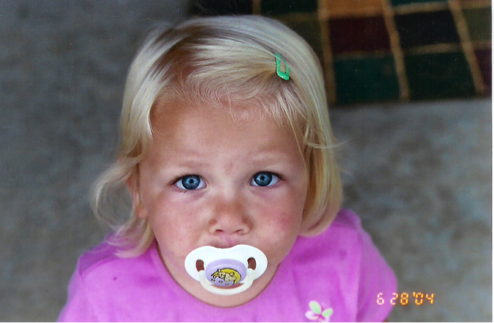
My name is Emme Ritzenthaler and this is my story. In September 2004, my life and my family’s life was forever changed. I was a normal 2 year old who was running, talking, feeding myself – just being a toddler but in the matter of a weekend that all changed. I could no longer sit up on my own, feed myself, or talk. These symptoms instigated a whirlwind of visits to doctors and specialists and a multitude of tests. It took a while but I was finally diagnosed with Opsoclonus Myoclonus Syndrome (OMS) which is an autoimmune disease that attacks the brain. OMS is so rare that it affects approximately 1 in 10 million per year. Fifty percent of the time OMS begins because of neuroblastoma, a tumor of the nervous system. This began a further set of tests to determine if I had this cancer – and I did – a golf ball sized tumor just above my adrenal gland. I had surgery, chemotherapy, and other treatments that lasted for years. At age seven I was cancer free but I still had to battle OMS.
Little did I know, it was going to take forever to find the right treatment, Ofatumumb, a type of chemotherapy. I went through immunosuppressive treatments, which worked for a while but caused many symptoms like migraines, blood exchanges which caused me to get multiple surgeries to get a central line and then ports, and other chemotherapies which lead me into anaphylactic shock. This caused me to be diagnosed with mental illnesses including depression and anxiety. I fell behind in school quickly and had a hard time making friends. Even though I struggled mentally, didn’t have many friends, and felt sick most of my life, I can finally say I have been the happiest I have ever been. The illness was all I knew for most of my life, and I had lost myself through the process, but it has made me truly find myself. I am almost eighteen and I am going to my dream college, the University of Cincinnati, to study Education next year. I still get treatment, and deal with my illness, but I am in a good place. I always try and tell other OMS warriors that it will be okay because the battles you fight can be rough but you will always be a warrior.
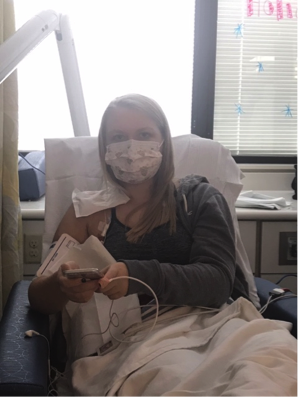
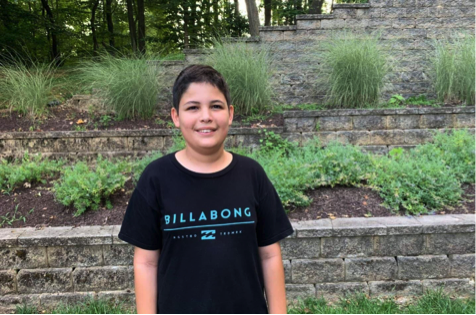
Joey’s onset was at age 2.5 in August 2008. Within 48 hours Joey, a happy and healthy child, lost the ability to walk, talk, feed himself and to hold his head up. His eyes darted back and forth nonstop and as the hours passed, new symptoms appeared. For 2.5 years Joey’s parents sought help, visiting multiple specialists across 5 states, none had a diagnosis or an explanation for Joey’s symptoms. In 2011, the family traveled to Illinois to see world renown specialist in OMS. The doctor diagnosed Joey with OMS and prescribed treatments that included chemotherapy treatments, high dose steroids and IVIG (immunotherapy treatments).
Today, Joey is 13 years old, celebrating 7 years in remission. Joey is excelling in school and thriving. Joey’s interests include visiting the beaches in Hawaii, hiking, swimming, and designing graphics and video games. Although OMS will always form a part of Joey’s story, it will never define him.
Opsoclonus myoclonus syndrome (OMS) is a rare disorder that affects the nervous system. Symptoms include rapid, multi-directional eye movements (opsoclonus), quick, involuntary muscle jerks (myoclonus), uncoordinated movement (ataxia), irritability, and sleep disturbance. The onset of OMS is usually abrupt and often severe. An underlying neuroblastoma (tumor) is often the cause and is located in over half of the children diagnosed with OMS. Others are diagnosed following a viral or bacterial infection. Treatment includes corticosteroids, chemotherapy, surgery, and/or radiation.

Grayson’s story is one that occurs in 1 in a million people worldwide. In early March 2016, at just 10 months old, we noticed that Grayson’s eyes started moving back and forth in a rapid, chaotic manner. We went to our pediatrician looking for answers, but left without a diagnosis. Grayson’s condition continued to decline rapidly over the next couple of weeks. Our happy baby became extremely fussy, hardly slept, wanted to be held all the time and wasn’t eating much. He ended up losing his developmental milestones; he could no longer sit on his own. He was unable to pull himself up and cruise around the furniture. The words he just learned to say, he no longer could verbalize. Our normal baby was completely silent and only communicated with us by smiling. We were on the search for answers, which led us to the ER of our local children’s hospital. Our ER visit turned into a hospital admission for “further testing.”
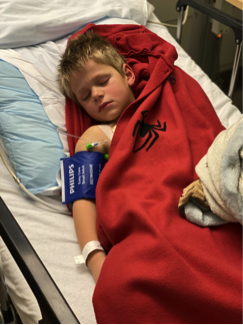
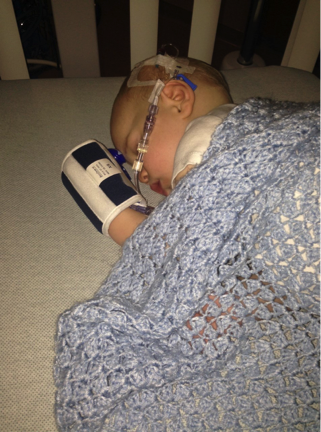
The next day brought us a lot of testing and an introduction to a pediatric neurologist. After many tests and consulting with other doctors, the neurologist diagnosed Grayson with Opsoclonus-Myoclonus-Ataxia Syndrome (OMAS). Grayson was her first OMAS case in 15 years. After receiving the devastating OMAS diagnosis, our neurologist referred us to the pediatric oncology department to investigate the occurrence of a Neuroblastoma tumor. Two days after being diagnosed with OMAS, a Neuroblastoma tumor was found along Grayson’s spine.
These two diagnoses sent us on a whirlwind of treatment protocols, procedures and surgery. Grayson was immediately started on IVIg and corticosteroids to treat his OMAS symptoms. A few days shy of his first birthday, Grayson underwent tumor resection surgery in which the surgeon was able to remove 95% of his tumor. In addition to IVIg, corticosteroids and surgery, Grayson has received chemotherapy, antibody therapy and adrenocorticotropic hormones, speech therapy and occupational therapy. Today, Grayson is 4.5years old. He still receives monthly IVIg treatments, but he doesn’t let that slow him down. He is your typical active preschooler. He loves football (especially the Kansas City Chiefs), skateboarding and playing outside with his brother and sister. We are looking forward to the day that Grayson kicks OMAS into remission
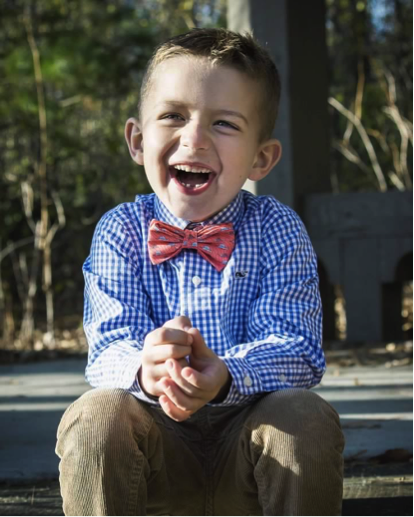
Because OMS is an autoimmune disorder, Will is likely to struggle with the effects for the rest of his life. But thanks to a dedicated medical team and family and friends that supported him in more ways than we can count, Will has a shot at a healthy and productive life. He will still have cognitive and physical hurdles to overcome, but what he has achieved throughout his journey cannot be measured on a scale or aptitude test. OMS kids are resilient fighters that overcome obstacles in every direction. Will’s disease has taught him to be strong and to persevere. He has to work harder for things the rest of us take for granted, but he never complains and his drive to succeed on his own is astounding.
Today, Will is able to do all of the things his older brother and his neighborhood friends do. He rides his bike, plays video games, shoots hoops in the driveway, and sits at the kitchen counter to do his homework. For all that he’s encountered in his short life, Will’s trials have only served to make him stronger and make him the wonderful, happy, independent kid he is today.
Will was diagnosed with OMS at 16 months. He had been a perfectly normal, happy baby until one day—out of the blue—he wasn’t. Our healthy boy, who had just mastered walking a few months before, suddenly lost the ability to walk, stand, sit, or crawl. He jerked violently and trembled all over and cried in our arms for hours on end for seemingly unknown reasons. Days in the hospital turned into weeks trying to determine a cause. He was misdiagnosed twice before a neurologist finally suggested Opsoclonus-Myoclonus Syndrome, simply because she had seen another case in a little girl the year before.
Now with a diagnosis, we started down the long road of treatment and therapy. Will endured years of steroids, infusions, chemotherapy and cancer drugs, x-rays and scans of every kind on every possible body part, daily injections, and trips cross-country to specialists and experts in this rare condition. He saw therapists multiple times a week for speech, occupational, and physical therapy. He endured more medical treatment and days in doctor’s offices and hospitals than most of us will see in our entire life, all before he was five years old.
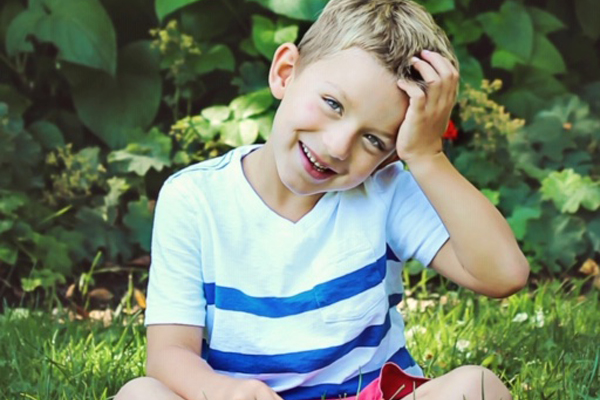
Valentino was born a healthy little boy that always had a smile on his face. He was running after his big sister by 10 months, hitting every milestone and was always so happy.
February 15th 2012, shortly after his first birthday Valentino woke up barely able to balance himself to stand-up, his beautiful smile was gone and his eyes would bounce around as if they couldn’t focus on anything. Our pediatrician rushed us to the local children’s hospital where our lives would forever change as we began a journey of trying to figure out what was wrong with him. Valentino’s symptoms were becoming worse each day that passed- his little body shook so hard that he could not sit up unassisted or sleep, he would scream in pain and would require to be held all day and night, he could barely swallow, his eyes bounced around so quickly… we thought we were losing him and prepared for the absolute worst outcome.

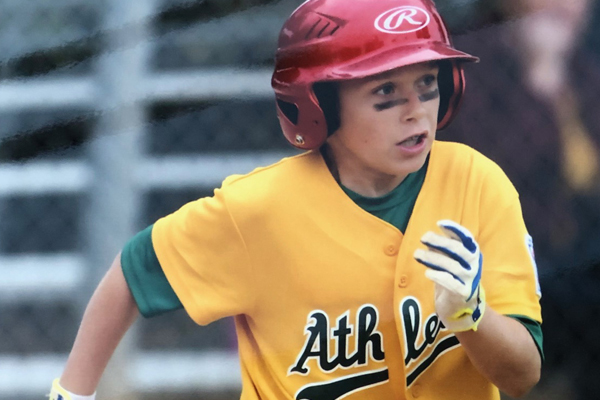
Doctors would apologize for not being able to help, we were told he would be mentally disabled, he would never ride a bike and that we would need to care for him for the rest of our lives…. We didn’t want to believe this, there has to be a way to treat him. So being his advocate we moved to a different children’s hospital and that is where we got answers and a diagnosis. Within days of being transferred, we were told that Valentino has Neuroblastoma and Opsoclonus Myoclonus Syndrome. We were heartbroken but so happy to have a plan to get our baby boy back.
Many surgeries, endless nights in the hospital, shots, infusions, steroids, chemo… many setbacks and many tears but here we are 8 years later and Valentino beat the odds. We are grateful for all of his doctors who helped get our boy back.
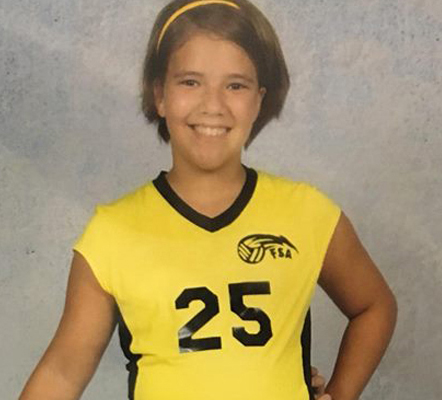
While her OMS was active, Alexa led an atypical life. She rarely ventured out in the public due to her compromised immune system. Normal activities such as play dates with friends, preschool, and other activities were discouraged by her doctors. Outings with friends and relatives were in small groups and only when they were healthy. Her therapies and schooling took place at home.
Since remission, Alexa has excelled. She is an active young girl who enjoys typical pre-teen activities such as playing with friends, playing volleyball, learning to play guitar, and participating in dance class, girl scouts, and church. While the family was concerned about Alexa’s future, she has shown so far that she can take on anything thrown her way. She excels in school with no classroom accommodations and she participates in many events such as spelling bee, and honor choir. Alexa’s future looks bright as she often discusses becoming a teacher in the future.
It is because of Alexa’s challenges at an early age that her family decided they needed to give back to others battling Opsoclonus Myoclonus Syndrome. They founded The OMSLife Foundation in 2012 to provide resource information for others. We now serve over one thousand patients throughout the world. Our mission statement is “To raise awareness of Opsoclonus Myoclonus Syndrome, maintain a support network for patients and caregivers, and fund research”.
Alexa’s battle began in the fall of 2009 at the age of fifteen months. She toddled to bed one evening and did not walk again for months. During the early stages of illness, Alexa lost her ability to walk, sit up, talk, or even hold objects. Her parents took her to various doctors and specialists, but no one had a definitive answer for Alexa’s rapid deterioration of health. Despite many efforts, the family was unable to find any decent information on this unknown disease. After thirty days of searching for answers, the family reached out to a friend in Cincinnati happened to be a doctor. He directed them to Texas Children’s Hospital in Houston. After the 500-mile drive to Houston, Alexa received her diagnosis – Opsoclonus Myoclonus Syndrome (OMS).
Over the next four years, Alexa battled her OM as she endured countless scans, tests, therapies, and medical treatments. She utilized a variety of therapies including speech, physical, and occupational therapies as she had to re-learn how to talk, sit, walk, grasp objects and other normal things that a young child learns. She encountered numerous setbacks and relapses, prompting treatment dosages to be adjusted. Finally, at the age of five years old, Alexa had her last IvIG treatment remains in remission.
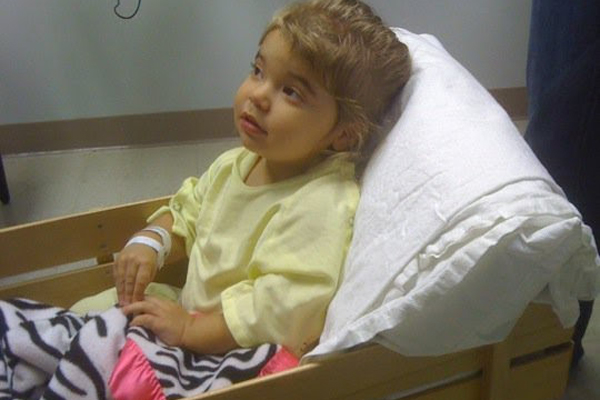
Pirouline © Since 2024. All Rights Reserved.